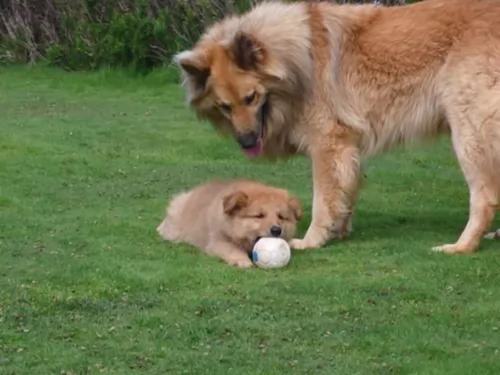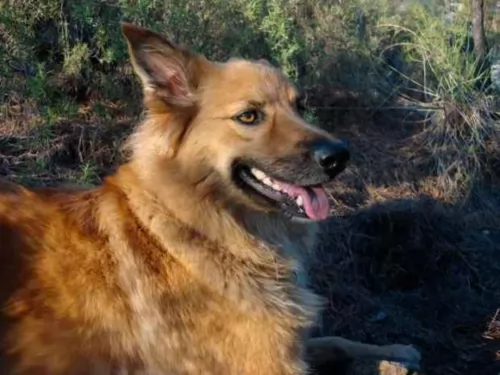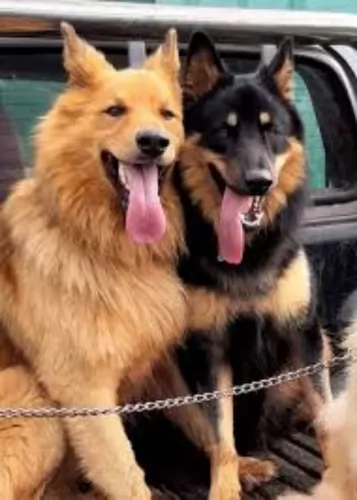 Petzlover
Petzlover Pastor Garafiano is originated from Spain but Shikoku is originated from Japan. Pastor Garafiano may grow 37 cm / 15 inches higher than Shikoku. Pastor Garafiano may weigh 18 kg / 39 pounds lesser than Shikoku. Both Pastor Garafiano and Shikoku has almost same life span. Pastor Garafiano may have more litter size than Shikoku. Both Pastor Garafiano and Shikoku requires Moderate Maintenance.
Pastor Garafiano is originated from Spain but Shikoku is originated from Japan. Pastor Garafiano may grow 37 cm / 15 inches higher than Shikoku. Pastor Garafiano may weigh 18 kg / 39 pounds lesser than Shikoku. Both Pastor Garafiano and Shikoku has almost same life span. Pastor Garafiano may have more litter size than Shikoku. Both Pastor Garafiano and Shikoku requires Moderate Maintenance.
 Hailing from the Canary Islands, the Pastor Garafiano is a dog which was once used for working purposes but which is essentially a pet today.
Hailing from the Canary Islands, the Pastor Garafiano is a dog which was once used for working purposes but which is essentially a pet today.
Also known as the Spanish Collie, it is not really sure if the dog really has any links to the Collie.There are dog experts who claim that there are actually very few pure specimens of this dog because of interbreeding with other breeds such as the German Shepherd.
There was a time that the breed almost disappeared but a working group was established to further establish breeding centers for the dog. Today the Pastor Garafiano is a recognized breed and he has been registered since 1982.
 The Shikoku is from the Shikoku Island in Japan and they are very much like the Japanese Shiba Inu. There are six native Japanese dog breeds and the Shikoku is medium sized and sits in between the smaller Shiba Inu and the very large Akita Inu. All of the Japanese native breeds are members of the Spitz family. The Japanese have sorted their six breeds into 3 categories by size. Being medium size, the Shikoku is a member of the Shika-inus group. Others in this group are the Ainu Ken, the Kai Ken and the Kishu Inu. There are small differences between the three dogs in the Shika-inus group.
The Shikoku is from the Shikoku Island in Japan and they are very much like the Japanese Shiba Inu. There are six native Japanese dog breeds and the Shikoku is medium sized and sits in between the smaller Shiba Inu and the very large Akita Inu. All of the Japanese native breeds are members of the Spitz family. The Japanese have sorted their six breeds into 3 categories by size. Being medium size, the Shikoku is a member of the Shika-inus group. Others in this group are the Ainu Ken, the Kai Ken and the Kishu Inu. There are small differences between the three dogs in the Shika-inus group.
The Shikoku was bred to be a hunting dog in Kochi Prefecture to hunt boar and deer. Other names for the breed include Kochi-ken and Kishu dog or boar hound. This dog is considered to be the purest of the Japanese native dogs or Nihoken. They are today very , very rare. There are very few outsides of Japan, but some in North America are attempting to save the breed.
The are od Kochi Prefecture is a mountainous region with rough terrain that anyone outside of the area would have a hard time accessing. That is why the Shikoku is considered to be so pure as they were pretty well isolated in the mountains. The breeders were also isolated by the mountains and there was very little interbreeding. Although breeding the same dog, these different groups developed different lines of the Shikoku.
Documentation tells us that the number of originals lines was just two and these were the Western and Eastern Shikoku. The Western dog was known as the Mount Ishizuchi Shikoku and the Eastern as the Mount Tsurugi Shikoku. Within these two lines of Shikoku there are additional strains.
Within the Eastern line there is the Tokushima (lya) and the Koci-Aki strains. Within the Western line there is the Hata Uwahara, the Ehime-ken Shuso-gun and the Honkawa. Among these lines and strains, there are different coats and different colors; some heavier and some taller, but all figure into the development of the breed.
Finally, in the Showa Era the Japanese established the Dog Protective League and they began collecting the native dogs from around the country. They protected them so that the breed will go on. The Shikoku is today recognized as Foundation Stock by the AKC and it is fully recognized by the Japan Kennel Club, the Canadian Hound Club and the Shikoku has been declared a living Japanese “natural monument”.
Two bloodlines became the way the Shikoku were know after the war – the Honkawa and the Hata lines The Honkawa line were the descendants of the Choshun-go and the Hata line were the descendants of the Matsukaze-go. They bred the lines separately until 1955, when they mixed them to make the breed stronger. They are no longer considered separate in any way.
Because they are such primitive dogs, the Shikoku are good watch dogs and quite reserved with strangers. They need a lot of socialization to be a family pet but once they are, they make great companions. Intelligent, quick to learn and eager to please. Of the two lines of Shikoku dogs from the Western strains, the current Shikoku owes much of its current development to the Honkawa and Hata strains.
 This is a medium to large dog, with its hindquarters being a bit higher than the shoulders. The body is strongly built with a deep chest. He stands at between 55 to 64cm in height and weighs between 24 to 35kg.
This is a medium to large dog, with its hindquarters being a bit higher than the shoulders. The body is strongly built with a deep chest. He stands at between 55 to 64cm in height and weighs between 24 to 35kg.
The nose is black and the eyes brown. The ears are slightly erect. The double coat is long and thick and the color is almost golden or tawny, much like a lion. Puppies are born brown and the color changes as they get older.
The tail is long, and when the dog is in motion or alert the tail is lightly curled. He is an active dog requiring a lot of intensive physical exercise. It is therefore not recommended that he be kept on a small city property but that he be on a farm or have a large garden.
This is a good looking, confident sheepdog who is also intelligent and therefore easily trained. He makes a splendidly obedient pet when he has been trained and socialized.
He is docile, calm and friendly and good with children in the home who have been taught to be kind and gentle with him. Apart from regular play, make sure he gets his regular exercise and he is constantly allowed to be part of the family.
 Today’s Shikoku is a medium sized breed with a Spitz like body – square with a head that is wedge shaped. The ears are pointed, and the tail is curved and feathered. They have arched toes and hard pads with dark, hard nails.
Today’s Shikoku is a medium sized breed with a Spitz like body – square with a head that is wedge shaped. The ears are pointed, and the tail is curved and feathered. They have arched toes and hard pads with dark, hard nails.
The two lines of the Shikoku are slightly different in built and look. The Honkawa strain is slender and athletic; agile and single coated. They have dark eyes and most of them are black and tan.
On the other hand, the Hata strain is much heavier boned, with the front more muscular than the rear. They have small ears, a wide skull and a strong undercoat. His eyes are shaped differently than the Honkawa. Their coats are also mostly red and tan.
 The Pastor Garafiano is such a wonderful docile and friendly pet that he is guaranteed to make a wonderful companion for any family.
The Pastor Garafiano is such a wonderful docile and friendly pet that he is guaranteed to make a wonderful companion for any family.
He is a dog that simply loves spending time with his human family and won’t do well when left alone in the backyard day after day. Take good care of this beautiful tawny dog and give him your attention and you will have a wonderful canine friend that is difficult to beat in terms of loyalty and devotion.
 Your Pastor Garafiano can reach anything from 10 – 14 years of age if he is happy and well taken care of. Every dog however, can fall prey to one of the many common dog illnesses there are. Some of these are -
Your Pastor Garafiano can reach anything from 10 – 14 years of age if he is happy and well taken care of. Every dog however, can fall prey to one of the many common dog illnesses there are. Some of these are -
This is an inherited inflammatory disease of the skin, blood vessels and muscles. Signs of dermatomyositis can vary from mild to severe skin lesions and inflammation of muscles and even a decrease in muscle mass. Severely affected dogs can even have difficulty with swallowing. Symptoms of the disease are usually seen before the dog is 6 months of age.
This is an eye disease where there is a gradual deterioration of the retina. Dogs can become night blind early in the disease and as the disease goes on, they can even lose their daytime vision.
This is a very common dog ailment – the abnormal formation of the hip socket can cause pain, arthritis and even lameness. It is severe enough to know that dogs with hip dysplasia should never be bred.
 Being isolated as they were, the Shikoku was a fairly healthy breed, no genetic testing has been done. Despite this they suffer a few of the same potential issues as other breeds their size.
Being isolated as they were, the Shikoku was a fairly healthy breed, no genetic testing has been done. Despite this they suffer a few of the same potential issues as other breeds their size.
Otherwise this is an agile and hardy breed with no known congenital health issues.
 Groom your Pastor Garafiano at least twice a week. Your dog’s coat is fairly long and it sheds too and you want to make sure it doesn't become all matted. There are different brushes you can use for his beautiful coat.
Groom your Pastor Garafiano at least twice a week. Your dog’s coat is fairly long and it sheds too and you want to make sure it doesn't become all matted. There are different brushes you can use for his beautiful coat.
You can also use this grooming session to check other areas of your dog. Check inside his ears, check his eyes and feel for new or unusual lumps. Make sure to keep his nails trimmed.
Exercise your pet every day. Take him on walks or hikes and provide him with ball or frisbee games. Exercise keeps him fit and healthy but also happy and content.
Nutrition is of critical importance to your pet's wellbeing. It is important to know what your pet needs to stay healthy and have a strong immune system which can ward off disease.
There are some good commercially manufactured dog foods on the market but it is important to choose the one that doesn’t come filled with toxic colorants, preservatives and fillers. Protein should be high on the list of ingredients listed on the pet food packaging. Also make sure to feed your pet food that had been made for his size, his breed, his age and his energy requirements.
To provide some variety to your pet’s diet, give him some tasty home-made food. Dog’s do well on simplicity and consistency. Some boiled chicken, brown rice or pasta and some cooked vegetables such as spinach, sweet potato and carrots all chopped up and added into his dry kibble occasionally will keep him bright eyed and with his tail constantly wagging.
He’ll thank you for not varying his diet with things that can give him an upset stomach such as coffee, tea, popcorn, grapes, onions and chocolate.
 Feeding the puppy Be careful with feeding the puppy and adult as the breed is known to have a tendency toward obesity. Fresh food is better as it is what the breed has been used to, but a high quality puppy kibble is acceptable. Feed three times per day.
Feeding the puppy Be careful with feeding the puppy and adult as the breed is known to have a tendency toward obesity. Fresh food is better as it is what the breed has been used to, but a high quality puppy kibble is acceptable. Feed three times per day.
2.Feeding the adult He is a high energy dog so feed a high energy food designed for a medium sized dog. Feed in two meals each day.
4. Games and Exercises You will need a fenced yard for this breed and time to play with them. If not, you would need time to walk her more than once a day. They love to play indoors as well, chasing balls, learning new things. The breed make great companions for hiking, swimming, play frisbee or catch outside. They do well at agility, rally, obedience and flyball.